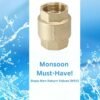
Understanding how does a mud pump work?
India’s monsoon season brings the challenge of waterlogging and flooding in many regions. Efficient dewatering solutions are essential to manage these water-related issues effectively. Among the various types of pumps available, self-priming dewatering, sewage submersible, and mud pumps stand out for their reliability and efficiency.
In this blog, we will explore these pumps, their working principles (i.e. how does a mud pump works), features, applications, and some of the best options available in the market.
What is a Self-Priming Dewatering Pump?
A self-priming dewatering pump is designed to re-prime itself automatically after the initial prime, making it highly effective for applications where suction lift is needed. These pumps are ideal for dewatering, sewage handling, and muddy water transfer. They eliminate the need for a foot valve and are capable of handling air and liquid mixtures, making them suitable for various challenging conditions.
How Does a mud pump work?
Self-priming dewatering pumps work by creating a partial vacuum in the pump casing, which allows them to draw air and water into the pump. Initially, the pump needs to be filled with water to start the priming process. Once primed, the impeller creates a vacuum that pulls water into the pump casing. The air is separated from the water and expelled through the discharge pipe, while the water is pushed through the system, creating a continuous flow. This mechanism allows the pump to handle both air and water, ensuring efficient operation even when there are air pockets in the system.
Features
–> Easy Installation and Low Operating Cost– Self-priming dewatering pumps are designed for easy installation, requiring minimal setup. Their low operating cost makes them an economical choice for long-term use.
–> Improved Efficiency and Minimal Maintenance– These pumps are engineered to operate on a common shaft, improving efficiency and reducing maintenance requirements. The simplified design minimizes wear and tear, ensuring longevity.
–> Efficient Self-Priming Action Without Foot Valve– The self-priming action of these pumps is designed for quick air release, eliminating the need for a foot valve. This feature enhances operational efficiency and reduces the complexity of the setup.
Applications
Self-priming dewatering pumps are versatile and can be used in a variety of applications, including:
- Pumping of sewage and effluents in bungalows, apartments, office/public buildings, schools, hotels, restaurants, and hospitals.
- Water recycling plants.
- Pumping of surface rainwater.
- Managing waterlogging in low-lying areas.
- Construction sites, mining operations, and agricultural fields.
After understanding what is a mud pump, how does a mud pump work and its features and applications, let’s explore the Best 3 Self-Priming Dewatering Pumps available in the market-
- Havells Sewage Submersible Mud Dewatering Pumps 0.5HP

Technical Details:
Horse Power: 0.37 kW (0.5 HP)
Supply: Single Phase
Maximum Working Pressure: 0.75 kg/cm²
Warranty: 1 Year
Application: Suitable for the transfer of dirty muddy water and pumping screened sewage water with small suspended soft solids.
Havells HSXB20-05-0.5HP is a robust and reliable pump designed for dewatering and sewage applications. It offers efficient performance with a low operating cost, making it an excellent choice for residential and commercial use. (Buying Link- Havells Sewage Submersible Mud Dewatering Pumps HSXB20-05)
- Havells Mud Dewatering 1HP Pump

Technical Details:
Horse Power: 1 HP
Supply: Single Phase
Warranty: 1 Year
Application: Suitable for the transfer of dirty muddy water and pumping screened sewage water with small suspended soft solids.
Havells 1HP Mud Dewatering Pump is vital for low-lying areas prone to waterlogging. It efficiently removes water from muddy areas, making it essential for construction sites, mining operations, and agricultural fields. This pump helps maintain dry working conditions, improve productivity, and protect equipment from water damage. (Buying Link- Havells Sewage Submersible Pump 1HP- Mud Pump)
- Texmo Taro Non-Clog Monoblock Self-Priming Pump [NMH]

Technical Details:
Head Range- 6 14 M, 6 – 14 M
Shaft- AISI 410
Impeller- CI FG 200
Application: Sewage treatment plants, Industrial wastewater and Drainage systems
The Taro Non-Clog Monoblock Self-Priming Pump NMH is a powerful solution designed for efficient water pumping. Manufactured by the reputable brand Taro, this pump ensures uninterrupted performance even in the toughest conditions. Its innovative design and self-priming feature make it incredibly convenient to use. Count on the Taro Non-Clog Monoblock Self-Priming Pump NMH for exceptional reliability, durability, and optimal performance in all your pumping needs. (For Taro Pumps Enquiry- call on (+91)9829213231)
In the face of the Indian monsoon, having efficient and powerful dewatering pumps is crucial to managing waterlogging and flooding. Get yourself a submersible pump right away, without any delay! Especially now that you have already understood how does a mud pump work.
Self-priming dewatering pumps, sewage submersible pumps, and mud pumps offer reliable solutions for various applications. Among the top choices are Havells Sewage Submersible Mud Dewatering Pumps HSXB20-05-0.5HP, Havells Mud Dewatering 1HP Pump, and Temo Taro Non-Clog Monoblock Self-Priming Pump NMH.
Investing in these pumps ensures efficient water management, helping you stay prepared for the monsoon season.
For consultation and any other query related to how does a mud pump work, call on (+91)9829213231.





